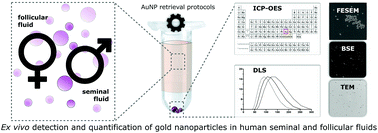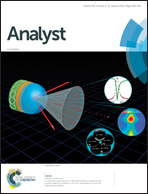Ex vivo detection and quantification of gold nanoparticles in human seminal and follicular fluids†
Abstract
Increasing consumption of engineered nanoparticles and occupational exposure to novel, ultrafine airborne particles during the last decades has coincided with deterioration of sperm parameters and delayed fecundity. In order to prevent possible adverse health effects and ensure a sustainable growth for the nanoparticle industry, the ability to investigate the nanosized, mineralogical load of human reproductive systems is becoming a real clinical need. Toward this goal, the current study proposes two methods for the detection and quantification of engineered nanoparticles in human follicular and seminal fluid, developed with the use of well-defined 60 nm Au particles. Despite the complexity of these biological fluids, simple physical and chemical treatments allow for the precise quantification of more than 50 and 70% wt of the spiked Au nanoparticles at low μg ml−1 levels in follicular and seminal fluids, respectively. The use of electron microscopy for the detailed observation of the detected analytes is also enabled. The proposed method is applied on a small patient cohort in order to demonstrate its clinical applicability by exploring the differences in the metal and particulate content between patients with normal and low sperm count.



 Please wait while we load your content...
Please wait while we load your content...